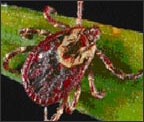
NYS announces Tick-Borne Illness Control Plan
BREWSTER, NY—New York State has some of the highest numbers of disease cases from ticks in the U.S. From 2004 to 2016, these numbers totaled 69,313, second only to Pennsylvania with 73,610, according to statistics from the Centers for Disease Control (CDC) and Prevention. So it was a timely announcement last week from the New York State Governor who unveiled a statewide tick-borne disease control plan. Details include expansion of tick control methods on public lands; increased education aimed at hikers, hunters and others at high risk; and a charge to the NYS Department of Health to pursue research partnerships to develop better diagnostic tests. A summit will be held this summer to advance the necessary research on Lyme and other tick-borne illnesses as part of this new state initiative.
“Part of Putnam’s charm comes from our abundant natural landscape of lakes and wooded areas,” says Putnam County Executive MaryEllen Odell. “With this country terrain, comes wildlife and insects, and unfortunately the diseases they carry. Almost everyone knows, or has heard of, someone who has had Lyme disease. This state support announced last week by Governor Cuomo is much needed and appreciated on the community level. On the personal level, it’s also important for all our residents to learn about and take basic precautions.”
“Diseases from infected ticks have more than doubled in the last 13 years in the United States,” says interim Health Commissioner Michael J. Nesheiwat, MD. “Unfortunately, these diseases are not going to disappear anytime soon. In fact, they are on the rise. The best protection we currently have is personal protection. So be vigilant: Apply repellent consistently and perform frequent tick checks. These actions can go a long way in preventing the bites and infection in the first place. They are especially important since no human vaccine is currently available.” Repellents should contain 20 percent or more of DEET (chemical name, N,N-diethyl-meta-toluamide).
More than a dozen tick-borne illnesses have been identified by the Centers for Disease Control (CDC) and Prevention, including five that infect residents in the Hudson Valley region. Lyme disease is the most common and the most well-known, but anaplasmosis, ehrlichiosis and babesiosis are increasing as well. Powassan disease, a rarer and potentially deadly infection, is also carried by the same black-legged tick, or “deer tick,” that transmits Lyme disease, anaplasmosis and babesiosis.
Environmental methods to reduce tick populations continue to be studied and their use will be expanded under the new NYS control plan. These techniques include dosing the deer and rodents that carry ticks with “tickicide” and application of eco-friendly tick-control treatments to parkland in the Hudson Valley. In some cases, permethrin-treated cotton balls which rodents use for nesting material will be used to kill ticks in the larval stage when they attach to the mice; in others a “tick control box” will apply the dog and cat preventative medicine fipronil to the rodents after they enter the box looking for bait. Additionally, the use of “tickicide” in feeding stations for the white-tailed deer will be expanded. This involves setting up rollers in a feeding station that brush tick insecticide on the deer as they eat. These stations are being used successfully in state parks on Long Island.
Testing for Lyme disease is currently challenging. If a blood test is performed too early, the results may come back negative even though the person is really infected. The test is most accurate a full week after the suspected bite so that a person’s antibodies have risen enough to be detected. A physician makes the final diagnosis based on a combination of available tests, observation of the patient, and the patient history and description of symptoms. Currently the only way Lyme disease can be diagnosed with certainty is when the patient has the tell-tale bullseye rash. However, this only occurs in 70 to 80 percent of infected individuals. This summer, academic institutions, local health departments and professional organizations will gather at the summit to strategize about advancing diagnosis, prevention, and other best practices.
Another challenge is that a small percentage of patients who get Lyme disease have continuing symptoms after completing treatment with antibiotics. They may complain of fatigue, joint pain or muscle aches. However the cause of these lingering symptoms is not completely understood. Sometimes this is called “chronic Lyme disease,” but the accurate medical name is “post-treatment Lyme disease syndrome.”
Residents who have been bitten by a tick and develop symptoms within 30 days should visit their healthcare provider. The most common symptoms include fever/chills, aches and pains, and a skin rash. Providers will evaluate symptoms and order diagnostic tests if indicated. For more details, visit the CDC’s webpage on “Symptoms of Tickborne Illness.”
The mission of the Putnam County Department of Health, nationally accredited by the Public Health Accreditation Board (PHAB), is to improve and protect the health of the Putnam County community, composed of nearly 100,000 residents. Core services include community health assessment, disease surveillance and control, emergency preparedness, environmental health protection, family health promotion and health education. For more information, please visit our County website at www.putnamcountyny.com; or visit our social media sites on Facebook at www.facebook.com/putnamhealth and Twitter @PutnamHealthNY.